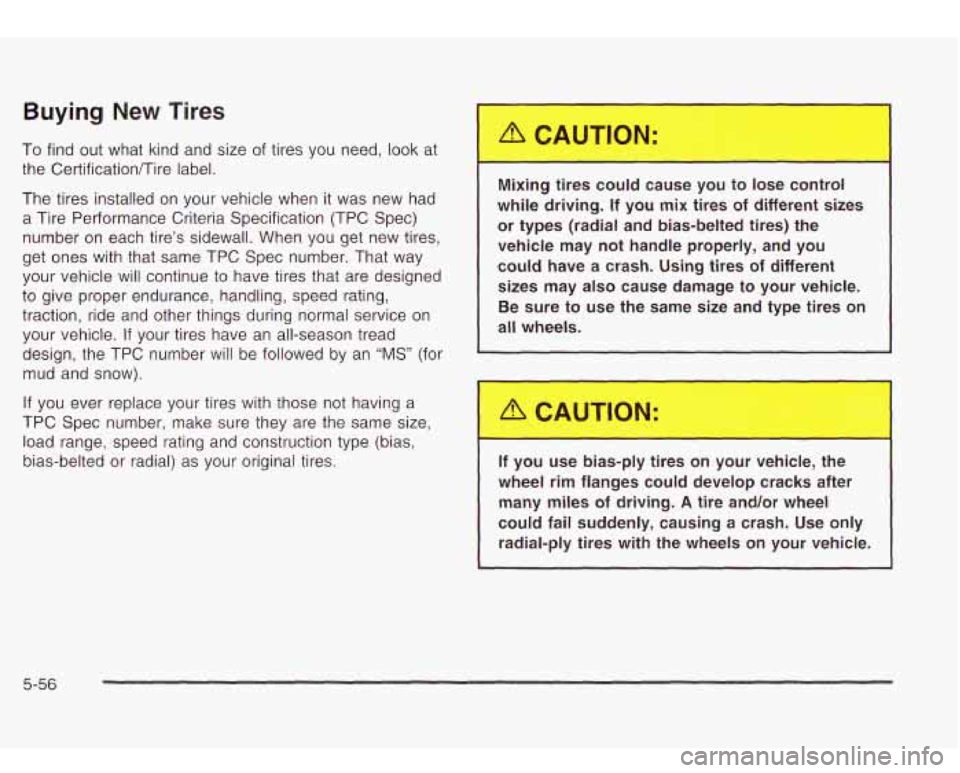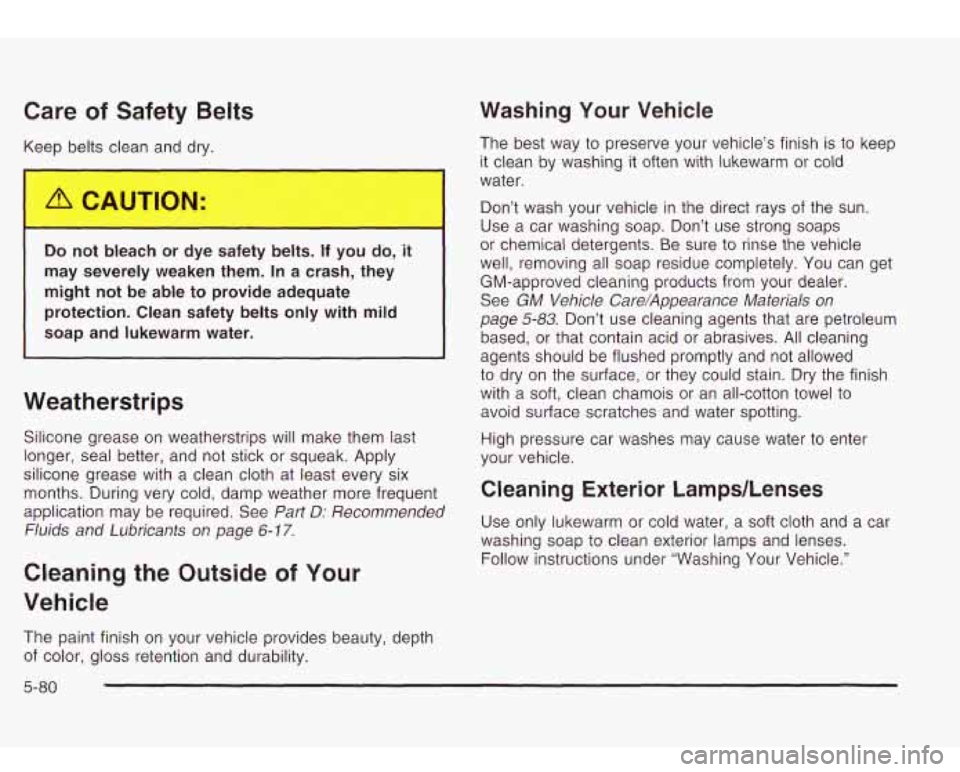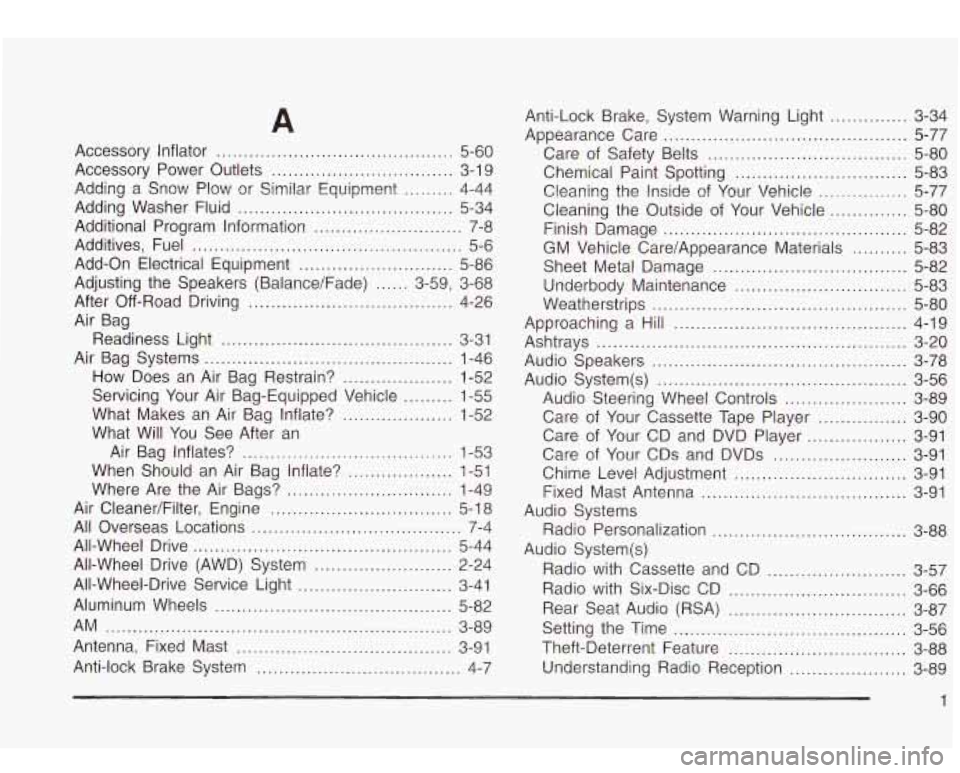2003 Oldsmobile Bravada belt
[x] Cancel search: beltPage 257 of 410

Par1 . on Hills
You really should not park your vehicle, with a
trailer attached,
on a hill. If something goes
wrong, your
rig could start to move. People
can be injured, and both your vehicle and the
trailer can be damaged.
When You Are Ready to Leave After
Parking on a
Hill
1. Apply your regular brakes and hold the pedal down
while you:
But
if you ever have to park your rig on a hill, here’s
how to do it:
1. Apply your regular brakes, but don’t shift into
PARK (P) yet. When parking uphill, turn your wheels
away from the curb. When parking downhill, turn
your wheels into the curb.
2. Have someone place chocks under the trailer
wheels.
3. When the wheel chocks are in place, release the
4. Reapply the regular brakes. Then apply your
regular brakes until
the chocks absorb the load.
parking brake, and then shift into PARK
(P).
5. Release the regular brakes.
start your engine,
shift into a gear, and
release the parking brake.
2. Let up on the brake pedal.
3. Drive slowly until the trailer is clear of the chocks.
4. Stop and have someone pick up and store the
chocks.
Maintenance When Trailer Towing
Your vehicle will need service more often when you’re
pulling a trailer. See the Maintenance Schedule for more
on this. Things that are especially important in trailer
operation are automatic transmission fluid (don’t overfill),
engine oil, axle lubricant, belt, cooling system and
brake system. Each
of these is covered in this manual,
and the Index will help you find them quickly.
If
you’re trailering, it’s a good idea to review these sections
before you start your trip.
Check periodically
to see that all hitch nuts and bolts
are tight.
4-52
Page 261 of 410

Section 5 Service and Appearance Care
Appearance Care ............................... ..... 5.77
Cleaning the Inside of Your Vehicle .... .... 5-77
Care of Safety Belts ...................................... 5-80
Weatherstrips
............................................... 5-80
Sheet Metal Damage
..................................... 5-82
Finish Damage ............................................. 5-82
Underbody Maintenance
................................ 5-83
Chemical Paint Spotting
................................. 5-83
GM Vehicle CarelAppearance Materials
........... 5-83
Vehicle Identification ...................................... 5-85
Vehicle Identification Number (VIN)
................. 5-85
Service Parts Identification Label
..................... 5-85
Cleaning
the Outside of Your Vehicle
.............. 5-80
Electrical System ......................................... 5-86
Headlamps
.................................................. 5.86
Windshield Wiper Fuses
................................ 5.86
Power Windows and Other Power Options
....... 5-86
Fuses and Circuit Breakers
............................ 5.86
Capacities and Specifications ......................... 5-93
Add-on
Electrical Equipment
........ ........... 5-86
Normal Maintenance Replacement Parts ~ ... 5-94
5-2
Page 315 of 410

Buying New Tires
To find out what kind and size of tires you need, look at
the Certificationnire label.
The tires installed on your vehicle when it was new had
a Tire Performance Criteria Specification (TPC Spec)
number on each tire’s sidewall. When you get new tires,
get ones with that same TPC Spec number. That way
your vehicle will continue
to have tires that are designed
to give proper endurance, handling, speed rating,
traction, ride and other things during normal service on
your vehicle. If your tires have an all-season tread
design, the TPC number will be followed by an
“MS” (for
mud and snow).
If you ever replace your tires with those not having a
TPC Spec number, make sure they are the same size,
load range, speed rating and construction type (bias,
bias-belted or radial) as your original tires. Mixi-.,
--:es could cause
, - . o lose control
while driving. If you mix tires
of different sizes
or types (radial and bias-belted tires) the
vehicle may not handle properly, and you
could have a crash. Using tires
of different
sizes may also cause damage to your vehicle. Be sure to use the same size and type tires on
all wheels.
If you
--e bias-pi, ;ires c.. yo^. Jehicle, the
wheel rim flanges could develop cracks after many miles of driving.
A tire and/or wheel
could fail suddenly, causing a crash. Use only
radial-ply tires with the wheels on your vehicle.
5-56
Page 339 of 410

Care of Safety Belts
Keep belts clean and dry.
L
Do nc, bleacl. _. Jye sa .--, Jelts. If yo^ -0, it
may severely weaken them.
In a crash, they
might not be able to provide adequate
protection. Clean safety belts only with mild
soap and lukewarm water.
Weatherstrips
Silicone grease on weatherstrips will make them last
longer, seal better, and not stick or squeak. Apply
silicone grease with a clean cloth at least every six
months. During very cold, damp weather more frequent
application may be required. See
Part D: Recommended
Fluids and Lubricants on page 6-7 7.
Cleaning the Outside of Your
Vehicle
The paint finish on your vehicle provides beauty, depth
of color, gloss retention and durability.
Washing Your Vehicle
The best way to preserve your vehicle’s finish is to keep
it clean by washing
it often with lukewarm or cold
water.
Don’t wash your vehicle in the direct rays
of the sun.
Use
a car washing soap. Don’t use strong soaps
or chemical detergents. Be sure to rinse the vehicle
well, removing all soap residue completely.
You can get
GM-approved cleaning products from your dealer.
See
GM Vehicle Care/Appearance Materials on
page
5-83. Don’t use cleaning agents that are petroleum
based, or that contain acid or abrasives.
All cleaning
agents should be flushed promptly and not allowed
to dry on the surface, or they could stain. Dry the finish
with
a soft, clean chamois or an all-cotton towel to
avoid surface scratches and water spotting.
High pressure car washes may cause water to enter
your vehicle.
Cleaning Exterior LampdLenses
Use only lukewarm or cold water, a soft cloth and a car
washing soap to clean exterior lamps and lenses.
Follow instructions under “Washing Your Vehicle.’’
5-80
Page 362 of 410

100,000 Miles (166 000 km)
0 Replace spark plugs. An Emission Control Service.
0 Change automatic transmission fluid and filter if
the vehicle is mainly driven under one or more
of these conditions:
- In heavy city traffic where the outside
temperature regularly reaches
90°F (32°C) or
higher.
- In hilly or mountainous terrain.
- When doing frequent trailer towing.
- Uses such as found in taxi, police or delivery
service.
0 If you haven’t used your vehicle under severe service
conditions listed previously and, therefore, haven’t
changed your automatic transmission fluid, change
both the fluid and filter
U Change transfer case fluid.
150,000 Miles (240 000 km)
U Drain, flush and refill cooling system (or every
60 months since last service, whichever occurs first).
See
Engine Coolant on page 5-22 for what to use.
Inspect hoses. Clean radiator, condenser, pressure
cap and neck. Pressure test the cooling system
and pressure cap.
An Emission Control Service.
0 Inspect engine accessory drive belt. An Emission
Control Service.
6-9
Page 364 of 410

At Least Twice a Year
Restraint System Check
Make sure the safety belt reminder light and all your
belts, buckles, latch plates, retractors and anchorages
are working properly. Look for any other loose or
damaged safety belt system parts. If you see anything
that might keep a safety belt system from doing its
job, have it repaired. Have any torn or frayed safety belts
replaced.
Also look for any opened or broken air bag coverings,
and have them repaired or replaced. (The air bag
system does not need regular maintenance.)
Wiper Blade Check
Inspect wiper blades for wear or cracking. Replace
blade inserts that appear worn or damaged or that
streak or miss areas of the windshield.
Also see
Cleaning the Outside of Your Vehicle on page 5-80.
Spare Tire Check
At least twice a year, after the monthly inflation check of
the spare tire determines that the spare is inflated
to
the correct tire inflation pressure, make sure that
the spare tire is stored securely. Push, pull, and then try
to rotate or turn the tire. If it moves, use the wheel
wrenchhatchet
to tighten the cable. See Changing a Flat
Tire on page
5-62.
Engine Air Cleaner Filter Restriction
Indicator Check
Your vehicle may be equipped with an engine air
cleaner filter restriction indicator located on the air
cleaner in the engine compartment. The indicator lets
you know when the air cleaner filter is dirty and needs
to
be changed. Check the indicator at least twice a year
or when your engine oil is changed, whichever
occurs first. See
Engine Air Cleaner/Fi/fer on page 5-18
for more information. Inspect your air cleaner filter
restriction indicator more often
if the vehicle is used in
dusty areas or under
off road conditions.
Weatherstrip Lubrication
Silicone grease on weatherstrips will make them last
longer, seal better, and not stick or squeak. Apply
silicone grease with a clean cloth. During very cold,
damp weather more frequent application may be required. See
Part D: Recommended Fluids and
Lubricants on page
6-17.
Automatic Transmission Check
Check the transmission fluid level; add if needed. See
Automatic Transmission Fluid on page 5-20. A fluid loss
may indicate a problem. Check the system and repair
if needed.
6-1 1
Page 388 of 410

A
Accessory Inflator ........................................... 5-60
Accessory Power Outlets
................................. 3-19
Adding a Snow Plow or Similar Equipment
......... 4-44
Adding Washer Fluid
....................................... 5-34
Additional Program Information
........................... 7-8
Additives, Fuel
................................................. 5-6
Add-on Electrical Equipment
............................ 5-86
After Off-Road Driving
..................................... 4-26
Readiness Light
.......................................... 3-31
Air Bag Systems
............................................. 1-46
Adjusting the Speakers
(Balance/Fade)
...... 3-59, 3-68
Air Bag
How Does an Air Bag Restrain?
.................... 1-52
Servicing Your Air Bag-Equipped Vehicle
......... 1-55
What Makes an Air Bag Inflate?
.................... 1-52
What Will You See After an
Air Bag Inflates?
...................................... 1-53
When Should an Air Bag Inflate? ................... 1-51
Where Are the Air Bags?
.............................. 1-49
Air Cleaner/Filter, Engine
................................. 5-1 8
All Overseas Locations
...................................... 7-4
All-Wheel Drive
............................................... 5-44
All-Wheel Drive (AWD) System
......................... 2-24
All-Wheel-Drive Service Light
............................ 3-41
Aluminum Wheels
........................................... 5-82
AM ............................................................... 3-89
Antenna, Fixed Mast
....................................... 3-91
Anti-lock Brake System
..................................... 4-7
Anti-Lock Brake. System Warning Light .............. 3-34
Appearance Care
............................................ 5-77
Care
of Safety Belts .................................... 5-80
Chemical Paint Spotting
............................... 5-83
Gleaning the Inside of Your Vehicle
................ 5-77
Cleaning the Outside of Your Vehicle
.............. 5-80
Finish Damage
............................................ 5-82
GM Vehicle Care/Appearance Materials .......... 5-83
Sheet Metal Damage
................................... 5-82
Underbody Maintenance
............................... 5-83
Weatherstrips
.............................................. 5-80
Approaching a Hill
.......................................... 4-19
Ashtrays
........................................................ 3-20
Audio Speakers
.............................................. 3-78
Audio System(s)
............................................. 3-56
Audio Steering Wheel Controls
...................... 3-89
Care of Your Cassette Tape Player
................ 3-90
Care of Your CD and DVD Player
.................. 3-91
Care of Your CDs and DVDs
........................ 3-91
Chime Level Adjustment
............................... 3-91
Fixed Mast Antenna
..................................... 3-91
Radio Personalization
.......... .............. 3-88
Radio with Cassette and CD
......................... 3-57
Radio with Six-Disc CD
................................ 3-66
Audio Systems
Audio System(s)
Rear Seat Audio (RSA)
................................ 3-87
Setting the Time
.......................................... 3-56
Theft-Deterrent Feature
................................ 3-88
Understanding Radio Reception
..................... 3-89
1
Page 389 of 410

Automatic Headlamp System ............................ 3-1 5
Automatic Transmission
Fluid
.......................................................... 5-20
Operation
................................................... 2-22
Automatic Transmission Check
.......................... 6-1 1
Automatic Transmission Shift Lock Control
System Check
....................................... ... 6-13
Backglass Wiper Blade Replacement
................. 5-51
Battery
.......................................................... 5-38
Battery Replacement
......................................... 2-6
Battery Run-Down Protection
............................ 3-1 9
Before Leaving on a Long Trip
......................... 4-33
Before You Drive
............................................ 3-76
Before You Go Off-Roading
.............................. 4-16
Body Lubrication Service
.................................. 6-12
Brake
Parking
...................................................... 2-25
System Inspection
....................................... 6-1 6
System Warning Light
.................................. 3-33
Brake Adjustment
............................................ 5-37
Brake Fluid
.................................................... 5-34
Brake Pedal Travel
..................................... 5-37
Brake Wear
............................................... 5-36
Brakes
.......................................................... 5-34
Braking
........................................................... 4-6
Backing
Up
.................................................... 4-51
BATTERY NOT CHARGING
............................. 3-53 Braking
in Emergencies
..................................... 4-8
Break.ln. New Vehicle
..................................... 2-18
Bulb Replacement
........................................... 5-47
Replacement Bulbs
...................................... 5-48
Buying New Tires
........................................... 5-56
Taillamps
and Turn Signal Lamps
.................. 5-47
C
California Fuel .................................................. 5-6
Canada
........................................................... 7-4
Canadian Owners
................................................ ii
Canadian Roadside Assistance ........................... 7-7
Capacities and Specifications
............................ 5-93
Care of
Carbon Monoxide
................... 4-36,
4-45, 2-13, 2-28
Safety Belts
................................................ 5-80
Your Cassette Tape Player
............................ 3-90
Your CD and DVD Player
............................. 3-91
Your CDs and DVDs
.................................... 3-91
Cargo Cover
.................................................. 2-44
Cargo Tie Downs
............................................ 2-45
Cassette Tape Messages
................................. 3-64
Cassette Tape Player Service
........................... 6-10
Center Seat Position, Child Restraints
................ 1-45
Chains, Tires
.............................................. 5-60
Charging System Light
................................ 3-32
Check
Engine Light
........................................... 3-35
Gages Warning Light
................................... 3-41
2